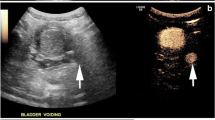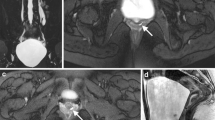Abstract
Background
Conventional imaging modalities are limited in the assessment of complex lower urinary tract anomalies including ectopic insertion of ureters. MR urography can be useful in these situations.
Objective
To share our experience with MR urography in assessing lower urinary tract anomalies and to determine its accuracy in depicting ectopic ureters.
Materials and methods
We conducted a retrospective review of all MR urography examinations done between November 2007 and March 2013 to note the presence or absence of duplex kidneys and insertion of ureters. We reviewed patient charts, surgical findings and results of other investigations including cystoscopy with retrograde ureterogram in order to establish presence or absence of ectopic ureter. This served as a reference standard against which we compared MR urography results.
Results
Of 22 MR urography examinations (3 boys, 19 girls; age range 3–16 years, mean 9.2 years) performed during the study period, 19 were performed to rule out ectopic ureters, two to assess complex anatomy and one to rule out crossing vessel in ureteropelvic junction obstruction. MR urography showed ectopic ureter in 9/19 children; one proved to be a false-positive. MR urography correctly showed normal insertion in 7/19 children. In the remaining 3/19 children distal ureter could not be seen, hence insertion was indeterminate on MR urography. One of these children had an ectopic ureter on cystoscopy and surgery. Statistical analysis showed MR urography’s sensitivity, specificity, positive predictive value (PPV) and negative predictive value (NPV) to be 88.8–100%, 70–90%, 75–88.8% and 90–100% for the detection of ectopic ureter.
Conclusion
MR urography is highly accurate in the assessment of ectopic ureters. In incontinent girls, MR urography should be the method of choice for depicting or ruling out ectopic ureter.


Similar content being viewed by others
References
Avni FE, Nicaise N, Hall M et al (2001) The role of MR imaging for the assessment of complicated duplex kidneys in children: preliminary report. Pediatr Radiol 31:215–223
Riccabona M, Ruppert-Kohlmayr A, Ring E et al (2004) Potential impact of pediatric MR urography on the imaging algorithm in patients with a functional single kidney. AJR Am J Roentgenol 183:795–800
Ehammer T, Riccabona M, Maier E (2011) High-resolution MR for evaluation of lower urogenital tract malformations in infants and children: feasibility and preliminary experiences. Eur J Radiol 78:388–393
Joshi M, Parelkar S, Shah H et al (2009) Role of magnetic resonance urography in the diagnosis of single-system ureteral ectopia with congenital renal dysplasia: a tertiary care center experience in India. J Pediatr Surg 44:1984–1987
Berrocal T, Lopez-Pereira P, Arjonilla A et al (2002) Anomalies of the distal ureter, bladder, and urethra in children: embryologic, radiologic, and pathologic features. Radiographics 22:1139–1164
Escala JM, Cadena Gonzalez Y, Lopez PJ et al (2008) Ectopic ureter in pediatrics. A change in the way of presentation. Arch Esp Urol 61:507–510
Roy Choudhury S, Chadha R, Bagga D et al (2008) Spectrum of ectopic ureters in children. Pediatr Surg Int 24:819–823
Lipson JA, Coakley FV, Baskin LS et al (2008) Subtle renal duplication as an unrecognized cause of childhood incontinence: diagnosis by magnetic resonance urography. J Pediatr Urol 4:398–400
Rohrschneider WK, Hoffend J, Becker K et al (2000) Combined static-dynamic MR urography for the simultaneous evaluation of morphology and function in urinary tract obstruction. I. Evaluation of the normal status in an animal model. Pediatr Radiol 30:511–522
Grattan-Smith JD (2008) MR urography: anatomy and physiology. Pediatr Radiol 38:S275–S280
Khrichenko D, Darge K (2010) Functional analysis in MR urography – made simple. Pediatr Radiol 40:182–199
Vivier PH, Dolores M, Taylor M et al (2010) MR urography in children. Part 1: how we do the F0 technique. Pediatr Radiol 40:732–738
Riccabona M, Avni FE, Dacher JN et al (2010) ESPR uroradiology task force and ESUR pediatric working group: imaging and procedural recommendations in pediatric uroradiology, part III. Minutes of the ESPR uroradiology task force minisymposium on intravenous urography, uro-CT and MR-urography in childhood. Pediatr Radiol 40:1315–1320
Conflicts of interest
None
Author information
Authors and Affiliations
Corresponding author
Rights and permissions
About this article
Cite this article
Figueroa, V.H., Chavhan, G.B., Oudjhane, K. et al. Utility of MR urography in children suspected of having ectopic ureter. Pediatr Radiol 44, 956–962 (2014). https://doi.org/10.1007/s00247-014-2905-4
Received:
Revised:
Accepted:
Published:
Issue Date:
DOI: https://doi.org/10.1007/s00247-014-2905-4




